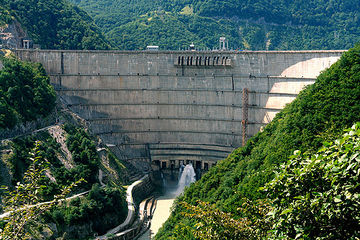Hydroelectric dam

A hydroelectric dam is one of the major components of a hydroelectric facility. A dam is a large, man-made structure built to contain some body of water. In addition to construction for the purpose of producing hydroelectric power, dams are created to control river flow and regulate flooding.[2] In some rivers, small scale dams known as weirs are built to control and measure water flow.
Dams are a type of retaining structure, which are structures built to create large standing bodies of water known as reservoirs. These reservoirs can be used for irrigation, electrical generation, or water supply. These structures are built on top of riverbeds and hold back water, raising the water level. Dikes can be built along with the dam to increase the dams effectiveness by preventing water from leaving the reservoir through secondary routes.[3]
Dams can range from relatively small to extremely large structures. The highest dam in the United states is located near Oroville, California and stands at 230 meters tall and 1.6 kilometers across.[2] The largest dam in the world is the Jinping dam on the Yalong river in China, standing at 305 meters tall. In Canada, there are more than 10 000 dams, with 933 categorized as being large dams.[4] The tallest dam in Canada is the Mica dam, on the Columbia river, standing at 243 meters tall. Another notable Canadian dam is the W.A.C Bennett dam on the Peace river, notable for its large reservoir volume of 7.4 x 109 cubic meters and height of 190.5 meters.
Construction
The construction of these dams is difficult and labour intensive. Before construction begins, water is diverted or prevented from moving through the construction site. After water is diverted, the foundation area is cleaned, excavated, and rock or sediments that will act as the foundation are repaired and deemed solid. This is done to ensure the rock or sediments won't shift or fail as a result of the load of the dam and reservoir. Supports known as rock bolts may be used to strengthen the foundation. Above the dam, rock bolts and netting may be used to prevent rocks from falling on the dam. Forms are then built along the edges of the dam, rebar is placed inside, and concrete is pumped in. This is done in sections, and the concrete is poured bit by bit in a block formation. Once enough of the dam is built, the reservoir is allowed to fill in a highly controlled manner. The dam is monitored during this process. Other structures that make the dam operational are then added.[5]
Operation
Dams are just one component of a complete hydroelectric facility, but are one major, visible component in the system. The purpose of a hydroelectric dam is to provide a place to convert the potential and kinetic energy of water to electrical energy by using a turbine and generator. Dams act as the place where water is held back and released in a controlled manner through hydraulic turbines, enabling the mechanical energy of the water to be transformed to electrical energy.[6]
Typical dams work to create a reservoir where water is stored at a given height. This height and the rate at which the water flows from the reservoir through the turbines determines how much electricity can be generated. This can be calculated by using the hydroelectric power equation. As the height of the dam increases, the amount of electricity generated increases as well. At the top of the dam is a gate that is used for blocking or allowing the release of water from the reservoir. This gate is opened or closed to meet electricity requirements. Between the top of the dam and the turbines are a series of channels known as penstocks that guide the water down and control the slope of the falling water to ensure maximum efficiency of the dam. Finally, turbines can be contained in the dam structure itself, and this is where the energy conversion takes place. After the water passes through the turbines, it is released in a tail race at the bottom of the dam back into the river.[6]
References
- ↑ Wikimedia Commons. (August 31, 2015). Ingur Hydroelectric Facility [Online]. Available: https://commons.wikimedia.org/wiki/File:Ingur_Hydroelectric_Power_Station.jpg
- ↑ 2.0 2.1 Missouri Botanical Garden. (August 31, 2015). Hydroelectric Power [Online]. Available: http://www.mbgnet.net/fresh/rivers/dams.htm
- ↑ Hydro Quebec. (September 1, 2015). Retaining Structures [Online]. Available: http://www.hydroquebec.com/learning/hydroelectricite/ouvrages-retenue.html
- ↑ Canadian Dam Association. (December 29, 2015). Dams in Canada [Online]. Available: http://www.imis100ca1.ca/cda/main/dams_in_canada/dams_in_canada/cda/dams_in_canada.aspx?hkey=2f98be19-d947-4aa2-9b2e-16a5202fe919
- ↑ Made How. (September 1, 2015). How Concrete Dams are Made [Online]. Available: http://www.madehow.com/Volume-5/Concrete-Dam.html
- ↑ 6.0 6.1 BrightHub Engineering. (September 1, 2015). How a Hydroelectric Dam Works [Online]. Available: http://www.brighthubengineering.com/building-construction-design/42794-how-does-a-hydroelectric-dam-work/

